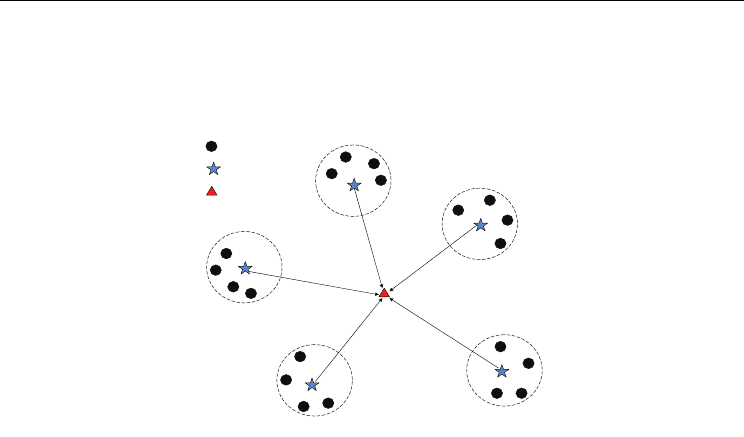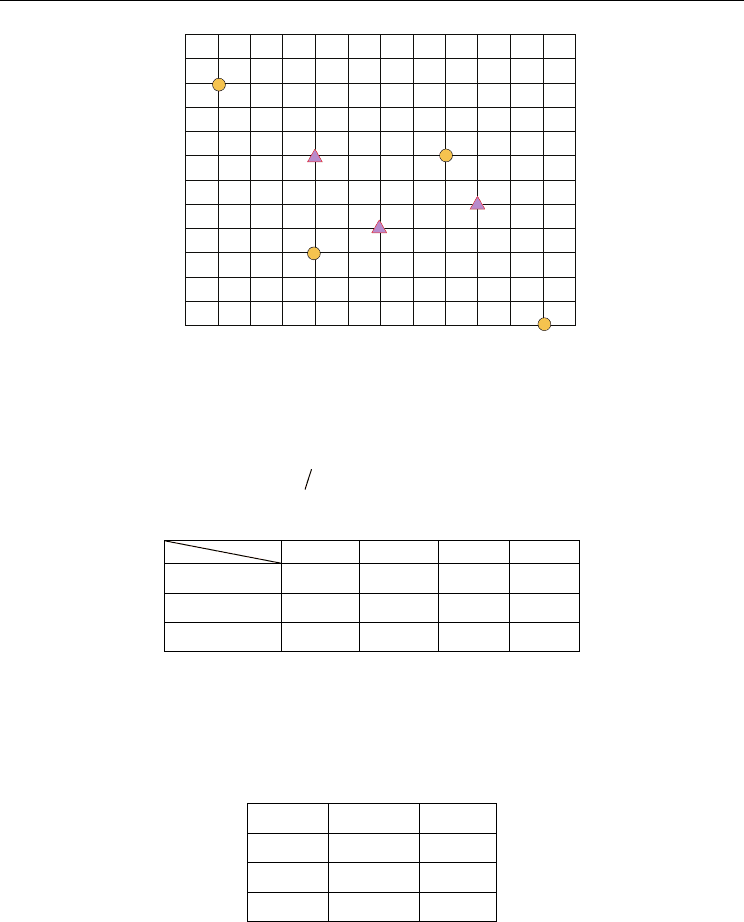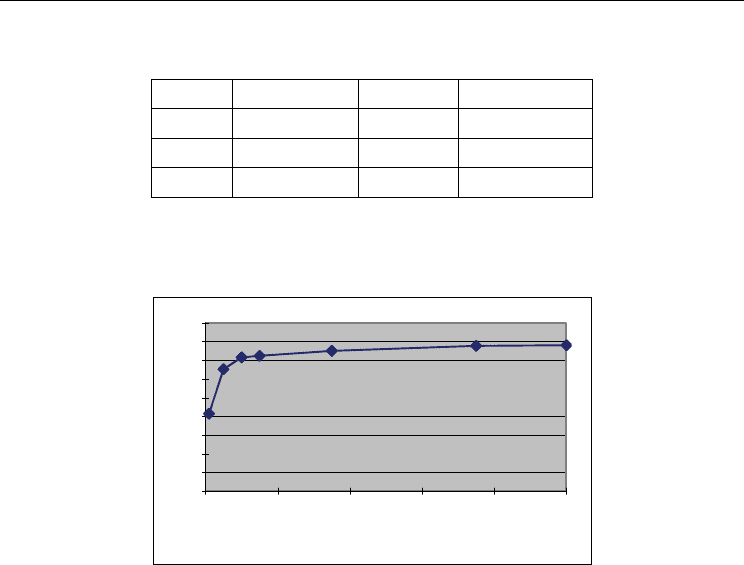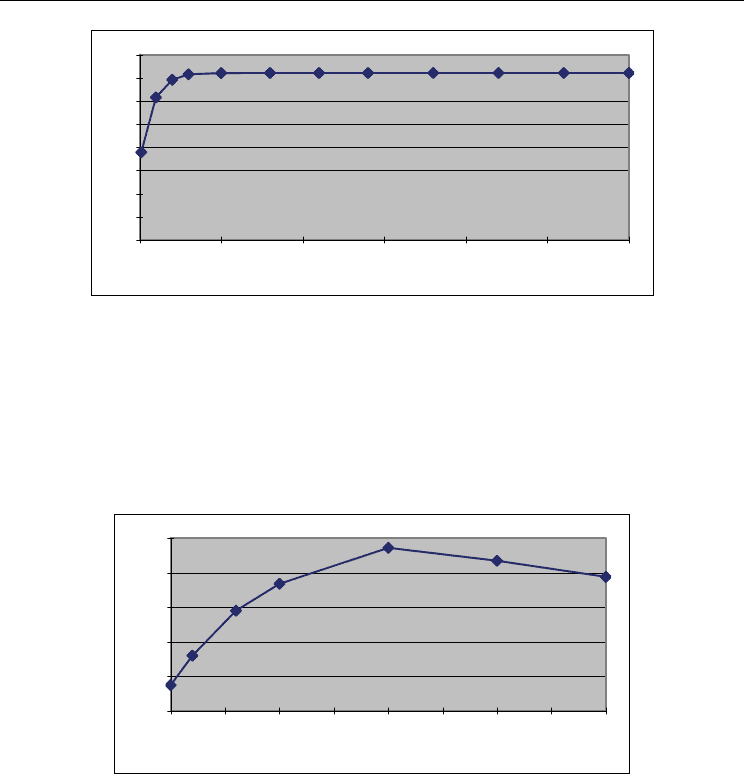Lazinica A. (ed.) Particle Swarm Optimization
Подождите немного. Документ загружается.


16
Finding Base-Station Locations in Two-Tiered
Wireless Sensor Networks by Particle Swarm
Optimization
*
Tzung-Pei Hong
1, 2
, Guo-Neng Shiu
3
and Yeong-Chyi Lee
4
1
Department of Computer Science and Information Engineering, National University of
Kaohsiung
2
Department of Computer Science and Engineering, National Sun Yat-sen University
3
Department of Electrical Engineering, National University of Kaohsiung
4
Department of Information Management, Cheng-Shiu University
Taiwan
1. Abstract
In wireless sensor networks, minimizing power consumption to prolong network lifetime is
very crucial. In the past, Pan et al. proposed two algorithms to find the optimal locations of
base stations in two-tiered wireless sensor networks. Their approaches assumed the initial
energy and the energy-consumption parameters were the same for all application nodes. If
any of the above parameters were not the same, their approaches could not work. Recently,
the PSO technique has been widely used in finding nearly optimal solutions for
optimization problems. In this paper, an algorithm based on particle swarm optimization
(PSO) is thus proposed for general power-consumption constraints. The proposed approach
can search for nearly optimal BS locations in heterogeneous sensor networks, where
application nodes may own different data transmission rates, initial energies and parameter
values. Experimental results also show the good performance of the proposed PSO
approach and the effects of the parameters on the results. The proposed algorithm can thus
help find good BS locations to reduce power consumption and maximize network lifetime in
two-tiered wireless sensor networks.
Keywords: wireless sensor network, network lifetime, energy consumption, particle swarm
optimization, base station.
2. Introduction
Recently, a two-tiered architecture of wireless sensor networks has been proposed and
become popular [1]. It is motivated by the latest advances in distributed signal processing
*
This is a modified and expanded version of the paper "A PSO heuristic algorithm for base-station
locations," presented at The Joint Conference of the Third International Conference on Soft Computing
and Intelligent Systems and the Seventh International Symposium on Advanced Intelligent Systems,
2006, Japan.

Particle Swarm Optimization
262
and source coding and can offer a more flexible balance among reliability, redundancy and
scalability of wireless sensor networks. A two-tiered wireless sensor network, as shown in
Figure 1, consists of sensor nodes (SNs), application nodes (ANs), and one or several base
stations (BSs).
SN
AN
BS
Figure 1. A two-tiered architecture of wireless sensor networks
Sensor nodes are usually small, low-cost and disposable, and do not communicate with
other sensor nodes. They are usually deployed in clusters around interesting areas. Each
cluster of sensor nodes is allocated with at least one application node. Application nodes
possess longer-range transmission, higher-speed computation, and more energy than sensor
nodes. The raw data obtained from sensor nodes are first transmitted to their corresponding
application nodes. After receiving the raw data from all its sensor nodes, an application
node conducts data fusion within each cluster. It then transmits the aggregated data directly
to the base station or via multi-hop communication. The base station is usually assumed to
have unlimited energy and powerful processing capability. It also serves as a gateway for
wireless sensor networks to exchange data and information to other networks. Wireless
sensor networks usually have some assumptions for SNs and ANs. For instance, each AN
may be aware of its own location through receiving GPS signals [11] and its own energy.
In the past, many approaches were proposed to efficiently utilize energy in wireless
networks. For example, appropriate transmission ways were designed to save energy for
multi-hop communication in ad-hoc networks [16][10][5][19][7][6][20]. Good algorithms for
allocation of base stations and sensors nodes were also proposed to reduce power
consumption [12][15][16][8][9]. Thus, a fundamental problem in wireless sensor networks is
to maximize the system lifetime under some given constraints. Pan et al. proposed two
algorithms to find the optimal locations of base stations in two-tiered wireless sensor
networks [13]. Their approaches assumed the initial energy and the energy-consumption
parameters were the same for all ANs. If any of the above parameters were not the same,
their approaches could not work.
In this paper, an algorithm based on particle swarm optimization (PSO) is proposed to find
the base-station locations for general power-consumption constraints. The PSO technique
was proposed by Eberhart and Kennedy in 1995 [2][3] and has been widely used in finding
solutions for optimization problems. Some related researches about its improvement and

Finding Base-Station Locations in Two-Tiered Wireless Sensor Networks
by Particle Swarm Optimization
263
applications has also been proposed [4][14][17][18]. It maintains several particles (each
represents a solution) and all the particles continuously move in the search space according
to their own local optima and the up-to-date global optimum. After a lot of generations, the
optimal solution or an approximate optimal solution is expected to be found. The proposed
approach here can search for nearly optimal BS locations in heterogeneous sensor networks.
Experimental results also show the performance of the proposed PSO approach on finding
the BS locations and the effects of the parameters on the results.
The remaining parts of this paper are organized as follows. Some related works about
finding the locations of base stations in a two-tiered wireless networks is reviewed in
Section 3. An algorithm based on PSO to discover base stations in a two-tiered wireless
networks is proposed in Section 4. An example to illustrate the proposed algorithm is given
in Section 5. Experimental results for demonstrating the performance of the algorithm and
the effects of the parameters are described in Section 6. Conclusions are stated in Section 7.
3. Review of Related Works
As mentioned above, a fundamental problem in wireless sensor networks is to maximize the
system lifetime under some given constraints. Pan et al. proposed two algorithms to find the
optimal locations of base stations in two-tiered wireless sensor networks [13]. The first
algorithm was used to find the optimal locations of base stations for homogenous ANs, and
the second one was used for heterogeneous ANs. Homogenous ANs had the same data
transmission rate and heterogeneous ANs might have different data transmission rates. In
their paper, only the energy in ANs was considered. If a single SN ran out of energy, its
corresponding AN might still have the capability to collect enough information. However, if
an AN ran out of energy, the information in its coverage range would be completely lost,
which was dangerous to the whole system.
Let d be the Euclidean distance from an AN to a BS, and r be the data transmission rate. Pan
et al. adopted the following formula to calculate the energy consumption per unit time:
)(),(
21
b
drdrp
αα
+=
, (1)
where α
1
is a distance-independent parameter, α
2
is a distance-dependent parameter, and b is
the Euclidean dimension. The energy consumption thus relates to Euclidean distances and
data transmission rates.
Pan et al. assumed each AN had the same α
1
,
α
2
and initial energy. For homogenous ANs,
they showed that the center of the minimal circle covering all the ANs was the optimal BS
location (with the maximum lifetime).
4. A General Base-Station Allocation Algorithm Based on PSO
The ANs produced by different manufacturers may own different data transmission rates,
initial energies and parameter values. When different kinds of ANs exist in a wireless
network, it is hard to find the optimal BS location. In this section, a heuristic algorithm
based on PSO to search for optimal BS locations under general constraints is proposed. An
initial set of particles is first randomly generated, with each particle representing a possible
BS location. Each particle is also allocated an initial velocity for changing its state. Let e
j
(0) be
the initial energy, r
j
be the data transmission rate, α
j1
be the distance-independent parameter,

Particle Swarm Optimization
264
and α
j2
be the distance-dependent parameter of the j-th AN. The lifetime l
ij
of an application
node AN
j
for the i-th particle is calculated by the following formula:
,)()0(
21
b
ijjjjjij
drel
αα
+=
(2)
where
b
ij
d
is the b-order Euclidian distance from the j-th AN to the i-th particle. The fitness
function used for evaluating each particle is thus shown below:
,)(
1
ij
m
j
lMinifitness
=
=
(3)
where m is number of ANs. That is, each particle takes the minimal lifetime of all ANs as its
fitness value. A larger fitness value denotes a longer lifetime of the whole system, meaning
the corresponding BS location is better. The fitness value of each particle is then compared
with that of its corresponding pBest. If the fitness value of the i-th particle is larger than that
of pBest
i
, pBest
i
is replaced with the i-th particle. The best pBest
i
among all the particles is
chosen as the gBest. Besides, each particle has a velocity, which is used to change the current
position. All particles thus continuously move in the search space. When the termination
conditions are achieved, the final gBest will be output as the location of the base station. The
proposed algorithm is stated below.
The proposed PSO algorithm for finding the best BS location:
• Input: A set of ANs, each AN
j
with its location (x
j
, y
j
), data transmission rate r
j
, initial
energy e
j
(0), parameters α
j1
and
α
j2
.
• Output: A BS location that will cause a nearly maximal lifetime in the whole system.
• Step 1: Initialize the fitness values of all pBests and the gBest to zero.
• Step 2: Randomly generate a group of n particles, each representing a possible BS
location. Locations may be two-dimensional or three-dimensional, depending on the
problems to be solved.
• Step 3: Randomly generate an initial velocity for each particle.
• Step 4: Calculate the lifetime l
ij
of the j-th AN for the i-th particle by the following
formula:
),()0(
2
b
ijjj1jjij
drel
αα
+=
where e
j
(0)
is the initial energy, r
j
is the data transmission rate, α
j1
is a distance-
independent parameter, α
j2
is a distance-dependent parameter of the j-th AN, and
b
ij
d
is the b-order Euclidean distance from the i-th particle (BS) to the j-th AN.
•
Step 5: Calculate the lifetime of the whole sensor system for the i-th particle as its fitness
value (fitness
i
) by the following formula:
ij
m
j
lMinifitness
1
)(
=
=
,
where m is number of ANs and i = 1 to n.
•
Step 6: Set pBest
i
as the current i-th particle if the value of fitness(i) is larger than the
current fitness value of pBest
i
.
•
Step 7: Set gBest as the best pBest among all the particles. That is, let:

Finding Base-Station Locations in Two-Tiered Wireless Sensor Networks
by Particle Swarm Optimization
265
fitness of pBest
k
=
n
i
max
1=
fitness of pBest
i
,
and set gBest=pBest
k
.
•
Step 8: Update the velocity of the i-th particle as:
)(()
idid
1
1
old
id
new
id
xpBestRandcVwV −××+×=
)(()
id
d2
2
xgBestRandc −××+
where
new
id
x
is the new velocity of the i-th particle at the d-th dimension,
old
id
x is the
current velocity of the i-th particle at the d-th dimension, w is the inertial weight, c
1
is
the acceleration constant for particles moving to pBest, c
2
is the acceleration constant for
particles moving to gBest, Rand
1
() and Rand
2
() are two random numbers among 0 to 1, x
id
is the current position of the i-th particle at the d-th dimension, pBest
id
is the value of
pBest
i
at the d-th dimension, and gBest
d
is the value of gBest at the d-th dimension.
•
Step 9: Update the position of the i-th particle as:
new
id
old
id
new
id
Vxx +=
,
where
new
id
x
and
old
id
x are respectively the new position and the current position of the i-th
particle at the d-th dimension.
• Step 10: Repeat Steps 4 to 9 until the termination conditions are satisfied.
In Step 10, the termination conditions may be predefined execution time, a fixed number of
generation or when the particles have converged to a certain threshold.
5. An Example
In this section, a simple example in a two-dimensional space is given to explain how the
PSO approach can be used to find the best BS location that will generate the nearly maximal
lifetime in the whole system. Assume there are totally four ANs in this example and their
initial parameters are shown in Table 1, where “Location” represents the two-dimensional
coordinate position of an AN, “Rate” represents the data transmission rate, and “Power”
represents the initially allocated energy. All α
j1
’s
are set at 0 and all α
j2
’s
at 1 for simplicity.
AN Location Rate Power
1 (1, 10) 5 10000
2 (11, 0) 5 10000
3 (8, 7) 4 6400
4 (4, 3) 4 6400
Table 1. The initial parameters of ANs in the example
For the example, the proposed PSO algorithm proceeds as follows.
• Step 1: The initial fitness values of all pBests and the gBest are set to zero.
• Step 2: A group of n particles are generated at random. Assume n is set at 3 in this
example for simplicity. Also assume the three initial particles randomly generated are
located at (4, 7), (9, 5) and (6, 4). Figure 2 shows the positions of the given ANs and the
initial particles, where the triangles represent the particles and the circles represent the
ANs.

Particle Swarm Optimization
266
1
2
3
4
3
1
2
12
11
1
10
9
8
2
3
4
5
6
7
0
11
1
10
98
2345
6
7
12
Figure 2. The positions of the given ANs and the initial particles
• Step 3: An initial velocity is randomly generated for each particle. In this example
assume the initial velocity is set at zero for simplicity.
• Step 4: The lifetime of each AN for a particle is calculated. Take the first AN for the first
particle as an example. Its lifetime is calculated as follows:
11.111])107()14[(510000
22
11
=−+−=l .
The lifetimes of all ANs for all particles are shown in Table 2.
1(1, 10) 2(11, 0) 3(8, 7) 4(4, 3)
1(4, 7) 111.11 20.41 100 100
2(9, 5) 22.47 68.97 320 55.17
3(6, 4) 32.79 48.78 123.08 320
Table 2. The lifetimes of all ANs for all particles
• Step 5: The lifetime of the whole sensor system for each particle is calculated as the
fitness value. Take the first particle as an example. Its fitness is calculated as follows:
Fitness(1)
= Min{l
11
, l
12
, l
13
, l
14
} = Min{111.11, 20.41, 100, 100} = 20.41.
In the same way, the fitness values of all the particles are calculated and shown in Table
3.
Particle Location Fitness
1 (4, 7) 20.41
2 (9, 5) 22.47
3 (6, 4) 32.79
Table 3. The fitness values of all the particles
• Step 6: The fitness value of each particle is compared with that of its corresponding
pBest. If the fitness value of the i-th particle is larger than that of pBest
i,
pBest
i
is replaced
with the i-th particle. In the first generation, the fitness values of all the pBests are zero,
smaller than those of the particles. The particles are then stored as the new pBests. The
Particle
AN

Finding Base-Station Locations in Two-Tiered Wireless Sensor Networks
by Particle Swarm Optimization
267
resulting pBests are shown in Table 4, where the field “appearance generation”
represents the generation number in which a particle is set as the current pBest.
Particle Location Fitness
Appearing
Generation
1 (4, 7) 20.41 1
2 (9, 5) 22.47 1
3 (6, 4) 32.79 1
Table 4. The pBests after the first generation
• Step 7: The best pBest
i
among all the particles is chosen as the gBest. In this example,
pBest
3
has the largest fitness value and is set as the gBest.
• Step 8: The new velocity of each particle is updated. Assume the inertial weight w is set
at 1, the acceleration constant c
1
for particles moving to pBest is set at 2, and the
acceleration constant c
2
for particles moving to gBest is set at 2. Take the first particle as
an example to illustrate the step. Its new velocity is calculated as follows:
)(()
1x1x
1
1
old
1x
new
1x
xpBestRandcVwV −××+×=
)(()
1x
d
2
2
xgBestRandc −××+
)46(25.02)44(5.0201 −×+−×+×=
= 1, and
)(()
1y1y
3
1
old
1y
new
1y
xpBestRandcVwV −××+×=
)(()
1y
d
4
2
xgBestRandc −××+
)74(125.02)77(1201 −×+−×+×=
= -0.75,
where the four random numbers generated are 0.5, 0.25, 1 and 0.125, respectively. In
the same way, the new velocities of the other two particles can be calculated. The
results are shown in Table 5.
Particle Old Location Velocity
1 (4, 7) (1, -0.75)
2 (9, 5) (-1.2, -0.2)
3 (6, 4) (0, 0)
Table 5. The new velocities of all the three particles
• Step 9: The position of each particle is updated. Take the first particle as an example. Its
new position is calculated as follows:
111
new old new
x
xx
x
xV=+
= 4 + 1
= 5, and
111
new old new
yyy
x
xV=+
= 7 + (-0.75)
= 6.25.

Particle Swarm Optimization
268
In the same way, the new positions of all the other two particles can be found. The
results are shown in Table 6.
Particle Old Location Velocity New Location
1 (4, 7) (1, -0.75) (5, 6.25)
2 (9, 5) (-1.2, -0.2) (7.8, 4.8)
3 (6, 4) (0, 0) (6, 4)
Table 6. The new positions of all the three particles
• Step 10: Steps 4 to 9 are then repeated until the termination conditions are satisfied. The
lifetime evolution along with different generations is shown in Figure 3.
0
5
10
15
20
25
30
35
40
45
0 20406080100
Generations
Lifetime
Figure 3. The evolution of the maximal lifetime for the example
6. Experimental Results
Experiments were made to show the performance of the proposed PSO algorithm on finding
the optimal positions of base stations. They were performed in C language on an AMD PC
with a 2.0GHz processor and 1G main memory and running the Microsoft Window XP
operating system. The simulation was done in a two-dimensional real-number space of
1000*1000. That is, the ranges for both x and y axes were within 0 to 1000. The data
transmission rate was limited within 1 to 10 and the range of initial energy was limited
between 100000000 to 999999999. The data of all ANs, each with its own location, data
transmission rate and initial energy, were randomly generated. Note that the data
transmission rates and the initial energy amounts of real-life sensors may not fall in the
above range. But the proposed approach is still suitable since the lifetime is proportional to
the initial energy amount and inversely proportional to the transmission rate.
Experiments were first made to show the convergence of the proposed PSO algorithm when
the acceleration constant (c
1
) for a particle moving to its pBest was set at 2, the acceleration
constant (c
2
) for a particle moving to its gBest was set at 2, the inertial weight (w) was set at
0.6, the distance-independent parameter (α
j1
) was set at zero, and the distance-dependent
parameter (α
j2
) was set at one. The experimental results of the resulting lifetime along with
different generations for 50 ANs and 10 particles in each generation are shown in Figure 4.

Finding Base-Station Locations in Two-Tiered Wireless Sensor Networks
by Particle Swarm Optimization
269
0
10
20
30
40
50
60
70
80
0 50 100 150 200 250 300
Generations
Lifetime
Figure 4. The lifetime for 50 ANs and10 particles
It is easily seen from Figure 4 that the proposed PSO algorithm could converge very fast
(below 50 generations). Next, experiments were made to show the effects of different
parameters on the lifetime. The influence of the acceleration constant (c
1
) for a particle
moving to its pBest on the proposed algorithm was first considered. The process was
terminated at 300 generations. When w = 1 and c
2
= 2, the nearly optimal lifetimes for 50ANs
and 10 particles along with different acceleration constants (c
1
) are shown in Figure 5.
67,5
68
68,5
69
69,5
70
0 0,5 1 1,5 2 2,5 3 3,5 4
c
1
Lifetime
Figure 5. The lifetimes along with different acceleration constants (c
1
)
It can be observed from Figure 5 that the lifetime first increased and then decreased along
with the increase of the acceleration constant (c
1
). When the value of the acceleration
constant (c
1
) was small, the velocity update of each particle was also small, causing the
convergence speed slow. The proposed PSO algorithm might thus not get the optimal
solution after the predefined number of generations. On the contrary, when the value of the
acceleration constant (c
1
) was large, the velocity change would be large as well, causing the
particles to move fast. It was then hard to converge. In the experiments, the optimal c
1
value
was about 2. Next, experiments were made to show the effects of the acceleration constant
(c
2
) for a particle moving to its gBest on the proposed algorithm. When w = 1 and c
1
= 2, the
experimental results are shown in Figure 6.

Particle Swarm Optimization
270
68,4
68,6
68,8
69
69,2
69,4
69,6
69,8
70
01234
c
2
Lifetime
Figure 6. The lifetimes along with different acceleration constants (c
2
)
It can be observed from Figure 6 that the lifetime first increased and then decreased along
with the increase of the acceleration constant (c
2
). The reason was the same as above. In the
experiments, the optimal c
2
value was about 2. Next, experiments were made to show the
effects of the inertial weight (w) on the proposed algorithm. When c
1
= 2 and c
2
= 2, the
experimental results are shown in Figure 7.
62
64
66
68
70
72
74
00,511,522,53
w
Lifetime
Figure 7. The lifetimes along with different inertial weights (w)
It can be observed from Figure 7 that the proposed algorithm could get good lifetime when
the inertial weight (w) was smaller than 0.6. The lifetime decreased along with the increase
of the inertial weight (w) when w was bigger than 0.6. This was because when the value of
the inertial weight was large, the particles would move fast due to the multiple of the old
velocity. It was then hard to converge. Next, experiments were made to show the relation
between lifetimes and numbers of ANs. The experimental results are shown in Figure 8.
